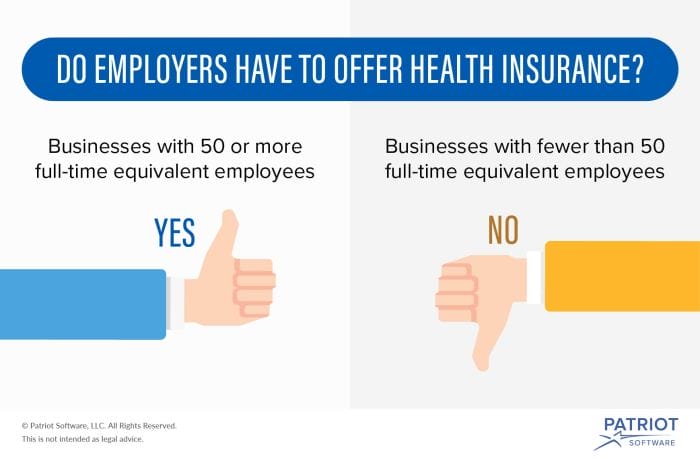In today’s competitive business landscape, offering health insurance to employees is no longer a luxury but a necessity. However, the rising cost of healthcare can make it a daunting task for businesses, especially small and medium-sized ones. In this comprehensive guide, we will explore 10 practical tips that employers can implement to make offering health insurance less painful and more manageable.
From optimizing health insurance plans to implementing wellness programs and leveraging technology, this guide provides actionable strategies to help businesses reduce costs, improve employee engagement, and ensure compliance with legal and regulatory requirements. Get ready to transform your health insurance offerings into a valuable asset that attracts and retains top talent while promoting a healthier and more productive workforce.
Define and Explain

In today’s competitive job market, offering health insurance is not just a perk, but a necessity for employers seeking to attract and retain top talent. It’s an essential component of a comprehensive benefits package that provides employees with access to quality healthcare, ensuring their well-being and productivity.
Significance of Offering Health Insurance
Offering health insurance offers several advantages to employers:
- Increased Employee Satisfaction: Employees value employers who prioritize their health and well-being. Health insurance demonstrates a commitment to employee care, leading to higher job satisfaction, loyalty, and retention.
- Recruitment and Retention: A comprehensive benefits package, including health insurance, is a powerful tool for attracting and retaining skilled employees. In a competitive job market, offering health insurance can give employers an edge in securing top talent.
- Reduced Absenteeism: Access to healthcare enables employees to address health issues promptly, reducing the likelihood of prolonged illnesses and absenteeism. This improves overall productivity and operational efficiency.
- Improved Productivity: Healthy employees are more engaged, productive, and have better focus. Offering health insurance supports employee well-being, leading to increased productivity and improved business outcomes.
Defining “Painful” in the Context of Offering Health Insurance
The term “painful” in the context of offering health insurance refers to the financial burden it can impose on businesses. The rising cost of healthcare has made it challenging for employers to provide comprehensive health insurance coverage without significantly impacting their bottom line.
This “pain” can manifest in several ways:
- Increased Premiums: The cost of health insurance premiums has been steadily increasing, putting pressure on employers’ budgets.
- Higher Deductibles and Co-payments: To offset rising premiums, insurers have increased deductibles and co-payments, shifting more of the financial burden onto employees.
- Narrower Networks: To control costs, insurers have narrowed their provider networks, limiting employees’ choices for healthcare providers.
- Reduced Coverage: Some employers have been forced to reduce the scope of their health insurance coverage to manage costs, leaving employees with fewer benefits.
These factors can make it challenging for businesses to offer health insurance that meets the needs of their employees without straining their financial resources.
Financial Considerations

Offering health insurance can be a significant financial burden for employers. However, there are strategies to reduce costs while still providing quality coverage.
One approach is to carefully evaluate the plan design. Consider factors such as deductibles, copayments, and coinsurance. Higher deductibles can lower premiums, but they may also increase out-of-pocket costs for employees. Copayments and coinsurance can also impact costs.
Shop Around
Obtaining quotes from multiple insurance carriers can help employers find the most competitive rates. It’s important to compare plans carefully, considering factors such as coverage, premiums, and deductibles.
Consider Self-Insurance
Larger employers may consider self-insurance, where they assume the financial risk of providing health insurance to their employees. This can potentially save money, but it also requires careful management and a strong financial foundation.
Wellness Programs
Implementing wellness programs can help reduce healthcare costs by promoting healthier lifestyles among employees. This can lead to lower claims and improved productivity.
Pharmacy Benefits
Negotiating favorable terms with pharmacies and generic drug manufacturers can help reduce prescription drug costs. Employers can also consider implementing a mail-order pharmacy program to save money on prescription drugs.
Employee Education and Engagement

Creating an informed and engaged workforce is crucial for successful health insurance offerings. Implementing effective educational strategies can empower employees to make informed decisions, increase their understanding of available options, and ultimately, promote higher participation and utilization rates.
To achieve this, employers should focus on developing comprehensive educational programs that address various employee needs, learning preferences, and literacy levels.
Interactive Workshops and Seminars
Organizing interactive workshops and seminars allows for in-person engagement and direct interaction between employees and healthcare professionals or benefits experts. These sessions provide a platform for detailed explanations of health insurance plans, coverage options, and utilization processes. Interactive formats, such as group discussions and role-playing scenarios, can enhance understanding and retention.
Personalized Online Resources
Creating a user-friendly online portal or mobile app dedicated to health insurance information empowers employees with 24/7 access to relevant resources. This platform can host plan brochures, FAQs, videos, and interactive tools that cater to different learning styles and preferences.
Personalized features, such as benefit calculators and comparison tools, can further enhance the user experience and decision-making process.
Targeted Communication Materials
Developing targeted communication materials tailored to specific employee groups can increase engagement and comprehension. These materials may include brochures, infographics, videos, and emails that address common questions, highlight plan features, and provide clear instructions for enrollment and claims submission. Utilizing multiple communication channels, such as company intranets, newsletters, and social media platforms, ensures that information reaches employees effectively.
Wellness Programs and Incentives

Implementing workplace wellness programs offers a myriad of benefits, including reduced healthcare costs, improved employee morale and productivity, and enhanced company reputation as a health-conscious employer. These programs aim to promote healthy behaviors, prevent chronic diseases, and create a supportive environment for overall well-being.
Program Design and Participation
Effective wellness programs are tailored to the specific needs and interests of the workforce. A comprehensive approach should incorporate various components, such as health screenings, nutrition counseling, fitness challenges, stress management workshops, and smoking cessation programs. Engaging employees in the design process ensures that the program resonates with their preferences and addresses their concerns.
Offering incentives, such as gym memberships, healthy snacks, or paid time off for participating in wellness activities, can further boost participation and encourage healthy habits.
Measuring Success and ROI
Tracking the success of wellness programs is crucial to demonstrate their impact on healthcare costs and employee well-being. Key metrics include participation rates, health screenings results, and changes in health behaviors. Measuring return on investment (ROI) involves comparing the costs of implementing the program with the savings generated through reduced healthcare expenses, absenteeism, and presenteeism.
Positive ROI demonstrates the value of investing in employee health and reinforces the importance of ongoing program support.
Data Analysis and Reporting

Collecting and analyzing data related to health insurance utilization is crucial for employers to make informed decisions about their health insurance plans. Data-driven insights enable employers to identify trends, assess the effectiveness of their plans, and tailor them to meet the specific needs of their employees.
By tracking claims data, employers can gain insights into the utilization patterns of their employees, including the frequency and types of medical services used, the cost of these services, and the overall health status of their workforce. This information helps employers identify areas where they can improve their plans, such as by adding new benefits or negotiating lower rates with providers.
Data-Driven Decision Making
- Utilization Review: Analyze claims data to identify high-cost or frequently used services. This can help employers negotiate lower rates with providers or implement cost-saving measures.
- Plan Design: Use data to determine which benefits are most valued by employees and which ones are underutilized. This information can guide employers in making changes to their plans that align with the needs of their workforce.
- Provider Network: Evaluate the performance of providers in the network based on cost, quality, and patient satisfaction. Employers can use this information to negotiate better contracts with providers or expand their network to include high-performing providers.
- Wellness Programs: Track the participation and outcomes of wellness programs to assess their effectiveness in improving employee health and reducing healthcare costs.
Legal and Regulatory Compliance
Adhering to the ever-evolving legal and regulatory landscape surrounding healthcare is paramount for employers offering health insurance. Navigating this complex terrain requires a proactive approach and comprehensive understanding of relevant laws and regulations.
To ensure compliance, employers should:
Stay Informed
- Monitor Healthcare Reform Updates: Continuously track changes to healthcare laws, including the Affordable Care Act (ACA), to adapt policies and practices accordingly.
- Review Regulatory Bulletins: Subscribe to regulatory updates from government agencies like the Department of Labor (DOL) and the Centers for Medicare & Medicaid Services (CMS) to stay abreast of new regulations and guidelines.
- Consult Legal Counsel: Seek advice from qualified legal professionals or in-house counsel to interpret complex healthcare regulations and ensure compliance.
Comply with Employer Mandates
- Offer Minimum Essential Coverage: Employers subject to the ACA’s employer mandate must provide health insurance that meets minimum essential coverage standards, as defined by the law.
- Adhere to Reporting Requirements: Comply with reporting obligations, such as filing Forms 1094-C and 1095-C, to document health insurance coverage offered to employees.
- Avoid Penalties: Failure to comply with employer mandates can result in significant penalties, including fines and tax consequences.
Protect Employee Rights
- Respect Privacy: Safeguard the confidentiality of employee health information in accordance with the Health Insurance Portability and Accountability Act (HIPAA) and other privacy laws.
- Prevent Discrimination: Ensure that health insurance plans do not discriminate against employees based on health status, genetic information, or other protected characteristics.
- Provide Reasonable Accommodations: Comply with the Americans with Disabilities Act (ADA) and other laws requiring employers to provide reasonable accommodations for employees with disabilities, including those related to health conditions.
Provider Networks and Quality of Care

Healthcare provider networks play a pivotal role in shaping the cost and quality of healthcare services. They comprise groups of healthcare providers, such as hospitals, clinics, and individual practitioners, who have contracted with insurance companies to provide care to their members.
The extent and quality of these networks can significantly impact the accessibility, affordability, and overall healthcare experience for employees.
Evaluating Provider Networks
When evaluating provider networks, employers should consider the following factors:
- Size and Scope: A larger network typically offers more choices and flexibility for employees, enabling them to select providers convenient to their location or preferences.
- Quality of Care: Assess the quality of care provided by the network’s providers. Look for providers who are accredited by reputable organizations and have a track record of delivering high-quality care.
- Cost-Effectiveness: Consider the cost of services provided by the network’s providers. Compare the charges with other providers in the area to ensure that they are reasonable and competitive.
- Access to Specialists: Evaluate the availability of specialists within the network. This is particularly important for employees with complex or chronic health conditions that require specialized care.
- Patient Satisfaction: Consider patient satisfaction ratings and reviews to gauge the overall experience of patients with the network’s providers.
Communication and Transparency

Establishing open and transparent communication between employers and employees is crucial for offering health insurance benefits effectively. When employees have a clear understanding of their coverage, they are more likely to utilize it, resulting in better health outcomes and reduced costs for the employer.
Strategies for Building Trust and Positive Relationships
- Regular Communication: Provide regular updates and reminders about health insurance benefits, including plan changes, new offerings, and upcoming deadlines.
- Transparency in Coverage: Ensure employees have easy access to detailed information about their coverage, including benefits, limitations, and costs.
- Open Door Policy: Encourage employees to ask questions and seek clarification regarding their health insurance benefits without fear of judgment.
- Personalized Communication: Tailor communication to meet the needs and preferences of individual employees. This may involve providing information in different languages or formats.
- Employee Feedback: Regularly seek feedback from employees to identify areas where communication can be improved and ensure that their needs are being met.
Technology and Automation

Technology offers substantial opportunities to enhance the efficiency, accuracy, and affordability of health insurance administration. It can automate tasks, streamline processes, and facilitate real-time data analysis, thereby reducing costs and improving the overall experience for both insurers and members.
Innovative technologies that can revolutionize health insurance management include:
Artificial Intelligence and Machine Learning
- AI and ML algorithms can analyze vast amounts of data to identify patterns and trends, enabling insurers to develop more accurate risk models, detect fraud, and personalize insurance plans.
- Chatbots and virtual assistants powered by AI can provide 24/7 customer support, answering member inquiries and resolving issues quickly and efficiently.
Blockchain
- Blockchain technology can enhance the security and transparency of health insurance transactions, reducing the risk of fraud and ensuring the integrity of data.
- It can facilitate secure and efficient data sharing among various stakeholders, such as insurers, providers, and members, improving coordination of care and reducing administrative burdens.
Internet of Things (IoT)
- IoT devices, such as wearable fitness trackers and smart home devices, can collect and transmit health-related data, enabling insurers to monitor member health and provide personalized recommendations for improving well-being.
- IoT data can also be used to develop innovative insurance products and services, such as usage-based insurance plans that reward members for healthy behaviors.
Benchmarking and Best Practices
Intro paragraphBenchmarking health insurance offerings against industry standards and best practices empowers employers to make informed decisions, improve employee satisfaction, and optimize healthcare spending. By learning from successful organizations and implementing effective strategies, employers can enhance the value of their health insurance offerings and create a healthier, more engaged workforce.
Set Clear Objectives
- Define specific goals for benchmarking, such as cost reduction, improved employee satisfaction, or enhanced health outcomes.
- Align objectives with the organization’s overall strategic goals and values.
Identify Relevant Metrics
- Select metrics that align with the defined objectives, such as healthcare costs, employee satisfaction scores, or health risk assessments.
- Gather data from reliable sources, such as industry reports, surveys, and internal data.
Conduct Thorough Research
- Study industry trends, best practices, and emerging innovations in health insurance.
- Analyze data from peer organizations, competitors, and industry leaders.
Implement Effective Strategies
- Adopt successful strategies that align with the organization’s goals and objectives.
- Monitor and evaluate the impact of implemented strategies on key metrics.
Foster Continuous Improvement
- Establish a process for ongoing benchmarking and performance monitoring.
- Regularly review and adjust strategies based on changing industry trends and organizational needs.
Last Word
Offering health insurance to employees doesn’t have to be a painful experience. By implementing the strategies Artikeld in this guide, businesses can alleviate the financial burden, enhance employee satisfaction, and create a healthier work environment. Embrace these tips and transform your health insurance offerings into a competitive advantage that sets your company apart and fosters a culture of well-being.
Helpful Answers
Q: What is the significance of offering health insurance as an employer?
A: Offering health insurance demonstrates your commitment to employee well-being, enhances employee satisfaction, attracts and retains top talent, improves productivity, and reduces absenteeism.
Q: What does “painful” mean in the context of offering health insurance?
A: “Painful” refers to the financial burden and administrative challenges associated with providing health insurance, particularly for small and medium-sized businesses.
Q: How can employers reduce the financial burden of offering health insurance?
A: Employers can reduce costs by optimizing health insurance plans, implementing wellness programs, analyzing data to make informed decisions, and leveraging technology to streamline administration.
Q: What are some strategies to optimize health insurance plans?
A: Strategies include conducting a thorough needs assessment, considering alternative plan designs, negotiating with insurance carriers, and implementing cost-sharing mechanisms.
Q: How can employers educate employees about their health insurance options?
A: Employers can educate employees through webinars, workshops, one-on-one consultations, and comprehensive communication materials that explain plan benefits, coverage details, and enrollment processes.



